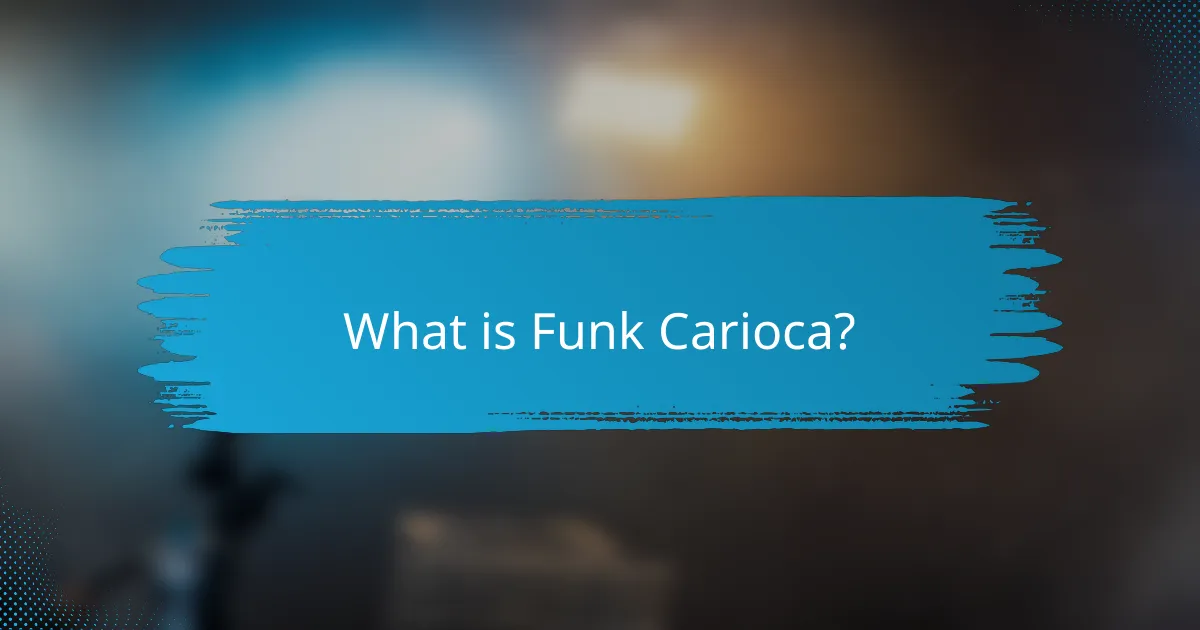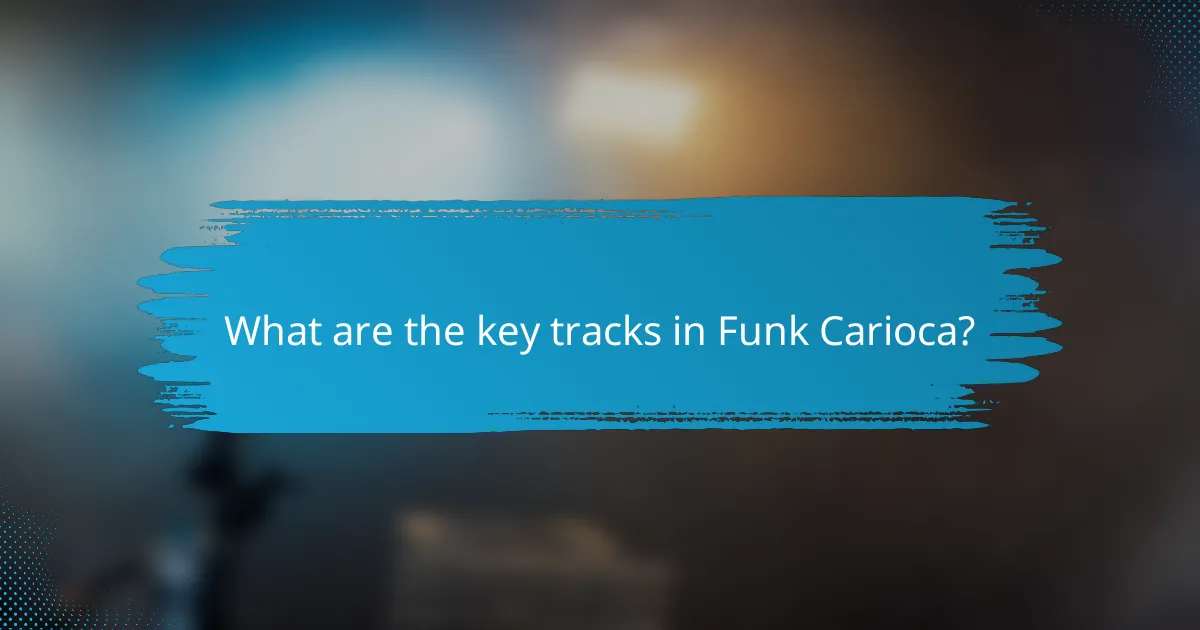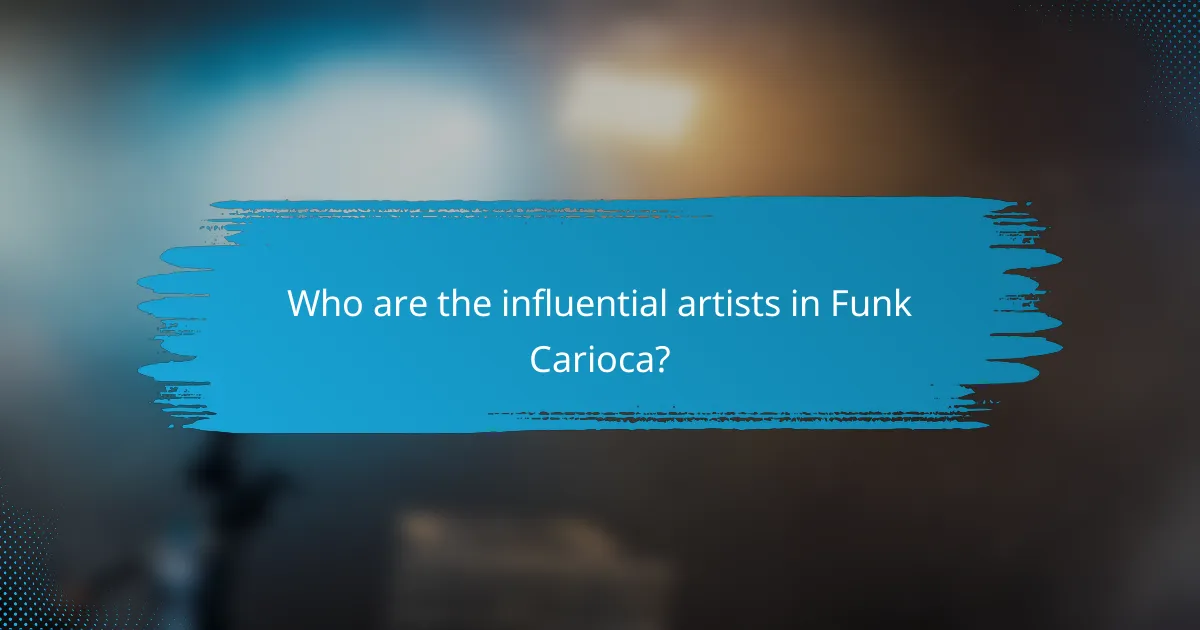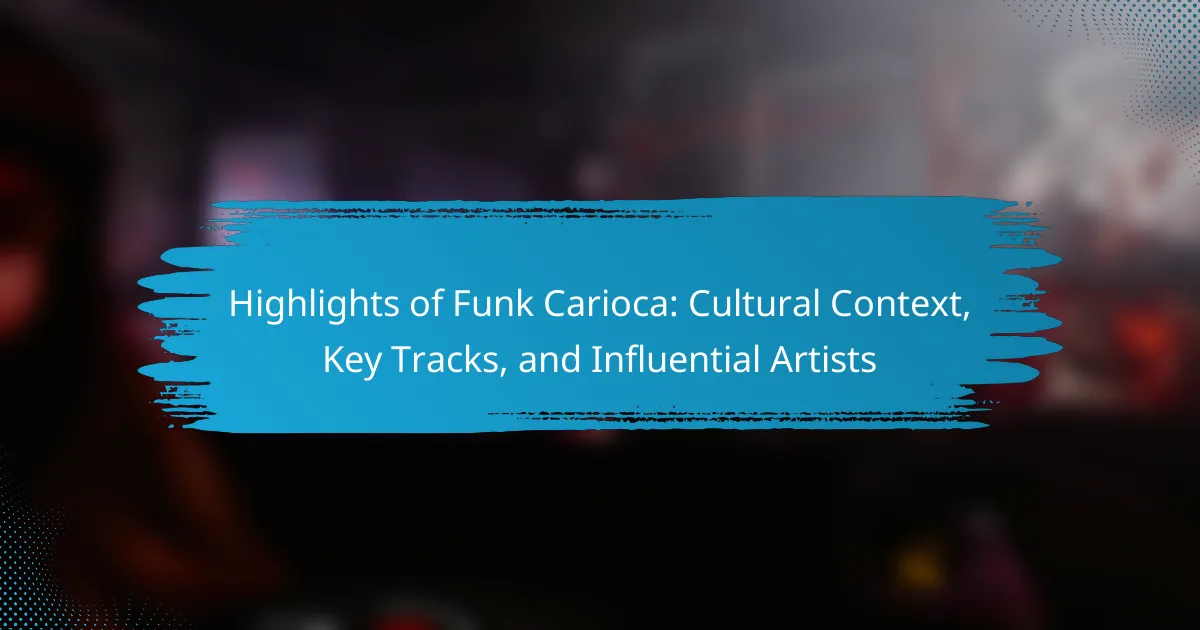Funk Carioca is a music genre that originated in the favelas of Rio de Janeiro, Brazil, combining hip-hop, electronic music, and traditional Brazilian rhythms. This genre, known for its fast-paced beats and explicit lyrics, emerged in the 1980s and gained traction in the 1990s, reflecting the socio-cultural realities of its communities. Key tracks such as “Rap da Felicidade,” “Bum Bum Tam Tam,” and “Que Tiro Foi Esse” highlight the diversity and cultural significance of Funk Carioca. Influential artists, including MC Kevinho, Anitta, and Ludmilla, have played crucial roles in popularizing the genre both nationally and internationally, contributing to Brazil’s vibrant music scene.

What is Funk Carioca?
Funk Carioca is a genre of music originating from the favelas of Rio de Janeiro, Brazil. It blends elements of hip-hop, electronic music, and traditional Brazilian rhythms. Funk Carioca is characterized by its fast-paced beats and often explicit lyrics. The genre emerged in the 1980s and gained popularity in the 1990s. It reflects the social and cultural realities of the communities where it developed. Key artists include DJ Marlboro and MC Leozinho. Funk Carioca has influenced dance styles and street culture in Brazil. It is also recognized internationally, contributing to Brazil’s diverse music scene.
How did Funk Carioca originate?
Funk Carioca originated in the favelas of Rio de Janeiro during the late 1980s. It emerged as a response to the socio-economic conditions faced by marginalized communities. The genre combines elements of Miami bass and traditional Brazilian music. Artists began to create tracks that reflected their experiences and struggles. The music gained popularity through local parties and radio stations. It was characterized by its fast beats and provocative lyrics. Over time, Funk Carioca evolved, influencing various cultural aspects in Brazil. It became a significant voice for youth in urban areas, promoting their identity and culture.
What cultural influences shaped the development of Funk Carioca?
Funk Carioca developed through a blend of various cultural influences. It emerged from the favelas of Rio de Janeiro in the 1980s. The genre is heavily influenced by Miami Bass and other forms of electronic music. Afro-Brazilian rhythms, such as samba and candomblé, also play a significant role. Socioeconomic factors, including poverty and social inequality, shaped its themes and lyrics. The genre reflects the struggles and celebrations of marginalized communities. Additionally, the influence of hip-hop culture is evident in its style and expression. These cultural elements combined to create a unique and vibrant musical form.
In what regions is Funk Carioca most popular?
Funk Carioca is most popular in Brazil, particularly in the favelas of Rio de Janeiro. This genre originated in the 1980s and has become a cultural staple in these communities. The vibrant rhythm and energetic dance styles resonate deeply with local youth. Additionally, Funk Carioca has gained popularity in other urban areas across Brazil. Cities like São Paulo and Salvador also embrace this music style. The genre’s influence has spread internationally, reaching audiences in Europe and the United States. Its unique blend of Brazilian culture and hip-hop elements contributes to its widespread appeal.
What are the defining characteristics of Funk Carioca?
Funk Carioca is a genre of music originating from Rio de Janeiro, Brazil. It is characterized by its fast-paced rhythms and heavy bass lines. The genre often incorporates elements of hip-hop, samba, and electronic music. Lyrics typically address themes such as social issues, love, and everyday life in the favelas. Funk Carioca is known for its energetic dance style, often seen in parties and clubs. The genre emerged in the 1980s and gained popularity in the 1990s. Its distinctive sound is created using drum machines and synthesizers. Funk Carioca has influenced various artists and music styles both in Brazil and internationally.
How does the musical style of Funk Carioca differ from other genres?
Funk Carioca differs from other genres primarily through its unique blend of electronic beats, Brazilian rhythms, and socially conscious lyrics. This genre originated in the favelas of Rio de Janeiro during the 1980s. It incorporates influences from Miami bass and hip-hop, resulting in a distinctive sound characterized by heavy basslines and fast tempos. Unlike traditional samba, Funk Carioca often addresses themes such as poverty, violence, and life in the favelas. The genre also promotes a vibrant party culture, emphasizing dance and community. Its lyrical content often reflects the struggles and realities faced by marginalized communities in Brazil, setting it apart from other musical styles.
What themes are commonly explored in Funk Carioca lyrics?
Funk Carioca lyrics commonly explore themes of social inequality, urban life, and party culture. They often reflect the struggles of life in favelas, highlighting issues like poverty and violence. Love and relationships are also frequent subjects, showcasing both romantic and tumultuous dynamics. Additionally, celebration and enjoyment of life are prominent, emphasizing dance and nightlife. The genre frequently addresses political issues, voicing the experiences of marginalized communities. These themes resonate with listeners, providing a raw and authentic depiction of Brazilian society.

What are the key tracks in Funk Carioca?
Key tracks in Funk Carioca include “Rap da Felicidade” by Cidinho e Doca. This track is considered a classic and reflects the genre’s roots. Another significant track is “Bum Bum Tam Tam” by MC Fioti, which gained international recognition. “Que Tiro Foi Esse” by Jojo Maronttinni also stands out, showcasing the genre’s evolution. “Desce Pro Pavao” by MC Lan is popular in recent years. These tracks highlight the diversity and cultural impact of Funk Carioca.
Which tracks are considered iconic in Funk Carioca?
Iconic tracks in Funk Carioca include “Rap da Felicidade” by Cidinho e Doca. This track is celebrated for its impactful lyrics and cultural significance. Another iconic song is “Vai Malandra” by Anitta, which gained international recognition. “Bonde do Tigrão” also represents the genre with its energetic beats. “Cerol na Mão” by DJ Marlboro is a classic that showcases the genre’s roots. These tracks have shaped the sound and identity of Funk Carioca over the years.
What makes these tracks significant in the genre?
These tracks are significant in the genre of Funk Carioca due to their innovative sound and cultural impact. They blend traditional Brazilian rhythms with electronic elements, creating a unique musical style. This fusion has influenced a new generation of artists and producers. The lyrics often address social issues, reflecting the realities of life in favelas. This connection to the community enhances their relevance and authenticity. Additionally, these tracks have gained international recognition, expanding the genre’s reach beyond Brazil. Their popularity in dance clubs and festivals showcases their appeal across diverse audiences. Overall, these tracks are pivotal in shaping the evolution of Funk Carioca.
How have these tracks influenced popular culture?
Funk Carioca tracks have significantly influenced popular culture by shaping music, fashion, and social movements in Brazil. These tracks popularized a unique sound that blends hip-hop, electronic, and traditional Brazilian music. They have inspired dance styles that are now mainstream in Brazilian nightlife. The lyrics often address social issues, reflecting the realities of marginalized communities. This has led to increased awareness and discussions on inequality in Brazil. Artists like MC Kevinho and Anitta have crossed over to international markets, further spreading the genre’s influence. The genre has also impacted fashion trends, with vibrant styles associated with its dance culture. Overall, Funk Carioca continues to evolve and influence various aspects of contemporary Brazilian culture.
What are the notable collaborations in Funk Carioca?
Notable collaborations in Funk Carioca include works by artists such as Anitta and DJ Snake. Anitta’s collaboration with Major Lazer on “Sua Cara” gained international acclaim. Another significant partnership is between MC Kevinho and Simone & Simaria, which produced the hit “Loka.” These collaborations showcase the genre’s blend of local and global influences. They highlight Funk Carioca’s appeal beyond Brazil. The merging of different musical styles contributes to its evolving sound.
Which artists have collaborated on successful Funk Carioca tracks?
Artists who have collaborated on successful Funk Carioca tracks include Anitta, Ludmilla, and DJ Marlboro. Anitta gained international fame with her hit “Show das Poderosas.” Ludmilla’s collaboration with DJ Will on “Hoje” was also a significant success. DJ Marlboro is known for his influential role in the genre, producing numerous hits. Other notable collaborations include those of MC Kevinho and MC Fioti, who have contributed to the genre’s popularity. These artists have collectively shaped the sound and reach of Funk Carioca.
What impact did these collaborations have on the genre?
Collaborations in Funk Carioca significantly broadened the genre’s appeal. They introduced diverse musical influences, blending traditional Brazilian sounds with modern beats. This fusion attracted a wider audience, both locally and internationally. Notable collaborations, such as those between artists like DJ Marlboro and various vocalists, helped popularize the genre across different demographics. Additionally, these partnerships led to innovative production techniques, enhancing the overall sound quality of Funk Carioca tracks. The increased visibility from collaborations also encouraged new artists to enter the scene, further enriching the genre. Overall, these collaborations played a crucial role in the evolution and mainstream acceptance of Funk Carioca.

Who are the influential artists in Funk Carioca?
Influential artists in Funk Carioca include MC Kevinho, Anitta, and Ludmilla. MC Kevinho is known for popularizing the genre with hits like “Olha a Explosão.” Anitta has gained international fame, blending funk with pop elements. Ludmilla is recognized for her powerful vocals and impactful lyrics in the scene. Other notable artists are DJ Renan da Penha and MC Fioti, who have contributed significantly to the genre’s growth and popularity. Their music often reflects the socio-cultural dynamics of Brazil, making them key figures in Funk Carioca’s evolution.
Which artists are considered pioneers of Funk Carioca?
Artists considered pioneers of Funk Carioca include DJ Marlboro, Claudinho e Buchecha, and MC Marcinho. DJ Marlboro is known for popularizing the genre in the 1990s. Claudinho e Buchecha gained fame with their hit “Quero Ver o Oco.” MC Marcinho contributed significantly with tracks like “Rap do Silva.” These artists shaped the sound and culture of Funk Carioca. Their influence is evident in the genre’s evolution and mainstream acceptance.
What contributions did these pioneers make to the genre?
Pioneers of Funk Carioca significantly shaped the genre by blending traditional Brazilian rhythms with contemporary electronic music. They introduced innovative sampling techniques that incorporated elements from hip-hop and dance music. Their work helped popularize the genre in Brazil and beyond, making it a staple in parties and clubs. Artists like DJ Marlboro and Cidinho & Doca brought unique lyrical themes that addressed social issues, resonating with the youth. Their contributions also included the creation of distinctive beats that defined the sound of Funk Carioca. This fusion of styles led to the emergence of a vibrant cultural movement. The genre’s growth can be traced back to these pioneers’ influence on subsequent artists and producers.
How have these artists shaped the sound of Funk Carioca?
Artists have significantly shaped the sound of Funk Carioca through their innovative styles. Their contributions include blending traditional Brazilian rhythms with hip-hop and electronic music. This fusion creates a unique sound that resonates with diverse audiences. Key figures in the genre, such as DJ Marlboro and MC Leozinho, have introduced distinctive beats and lyrical themes. These artists often address social issues, reflecting the realities of life in Brazilian favelas. Their influence has led to the genre’s evolution and mainstream acceptance. The rise of platforms like YouTube has further amplified their reach and impact. Overall, these artists have been pivotal in defining and popularizing Funk Carioca.
Who are the emerging artists in Funk Carioca today?
Emerging artists in Funk Carioca today include MC Poze do Rodo, Tati Quebra Barraco, and MC Cabelinho. MC Poze do Rodo gained attention for his unique style and relatable lyrics. Tati Quebra Barraco is known for her powerful presence and contributions to the genre. MC Cabelinho has made waves with his innovative sound and collaborations. These artists reflect the evolving landscape of Funk Carioca, showcasing its diversity and cultural significance. Their music resonates with younger audiences and addresses contemporary social issues.
What trends are these emerging artists bringing to Funk Carioca?
Emerging artists are bringing innovative sounds and diverse influences to Funk Carioca. They incorporate elements from genres like trap, reggaeton, and electronic music. This fusion creates a fresh auditory experience while maintaining the genre’s core rhythmic elements. Artists are also focusing on socially conscious lyrics that address contemporary issues. This trend reflects a growing awareness and engagement with societal topics. Collaborations with mainstream pop artists are becoming more common. Such partnerships help to broaden Funk Carioca’s audience. Additionally, the use of digital platforms for distribution and promotion is increasing. This shift allows for greater accessibility and visibility for new talent.
How are these artists connecting with new audiences?
Artists are connecting with new audiences through social media platforms. They utilize platforms like Instagram, TikTok, and YouTube to share their music and visuals. These platforms allow for direct engagement with fans. Artists often collaborate with influencers to reach broader demographics. Live-streaming events have also become popular, attracting diverse viewers. Additionally, the use of catchy challenges or trends on social media boosts visibility. Data shows that TikTok trends significantly increase song streams. This strategy effectively introduces Funk Carioca to global audiences.
What are some best practices for exploring Funk Carioca music?
To explore Funk Carioca music effectively, immerse yourself in its cultural context. Attend live performances to experience the energy and community involvement. Listen to key tracks from influential artists to understand the genre’s evolution. Research the historical roots of Funk Carioca, which originated in the favelas of Rio de Janeiro in the 1980s. Engage with online forums and social media groups dedicated to Funk Carioca for insights and recommendations. Analyze lyrics to grasp the social and political messages conveyed in the music. Collaborate with local artists or enthusiasts to gain firsthand knowledge and appreciation of the genre.
Funk Carioca is a vibrant music genre originating from the favelas of Rio de Janeiro, Brazil, characterized by its fast-paced rhythms, heavy basslines, and socially conscious lyrics. The article explores its cultural context, tracing its roots to the socio-economic conditions of the 1980s, and highlights key tracks and influential artists that have shaped its evolution. Notable figures such as DJ Marlboro, Anitta, and MC Kevinho are discussed, along with the genre’s impact on popular culture and emerging trends among new artists. Additionally, the piece provides insights into the themes commonly addressed in Funk Carioca lyrics and the significance of collaborations within the genre.
